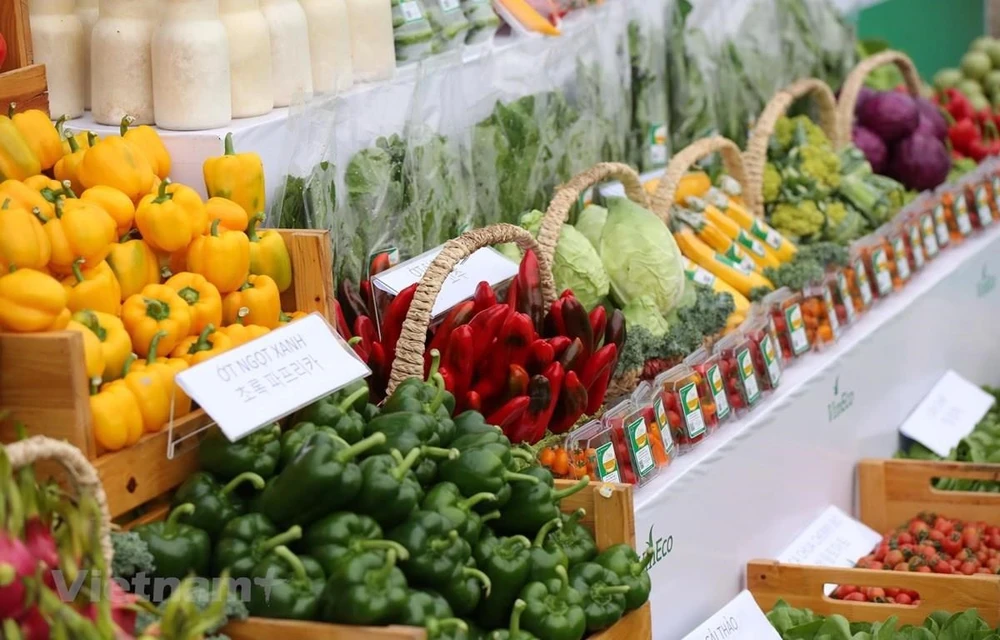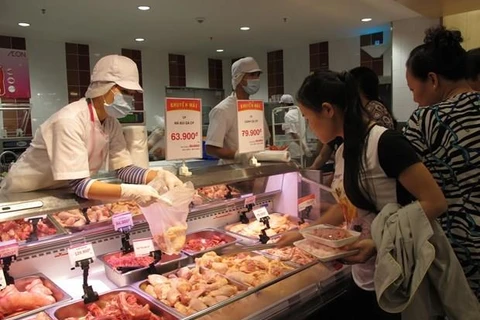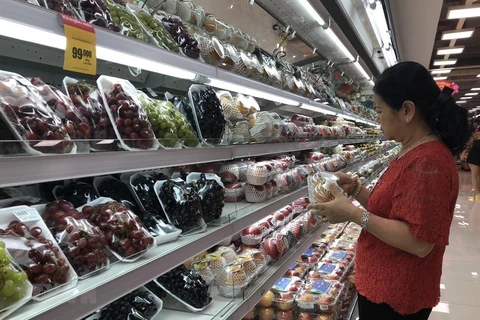
Hanoi (VNA) – Ten of the 11 categories of main consumer goods and services have recorded price hikes in October, with the strongest month-on-month increase, 1.04 percent, seen in the food and food services group as a result of the African swine fever epidemic.
Impact of the African swine fever has led to a sharp fall in pork supply in October. Additionally, higher gas, petrol and educational service prices have also negatively affected the consumer price index (CPI) in the month.
Do Thi Ngoc, Director of the General Statistics Office (GSO)’s Price Statistics Department, said although the State Bank of Vietnam has persisted in a flexible monetary policy to curb the CPI growth rate at 0.59 percent against September, this was still the fastest pace in the last three years.
The CPI in October expanded 2.79 percent from December 2018 and 2.24 percent year on year. However, the 10-month figure picked up just 2.48 percent from the same period last year, the lowest rise in three years.
[Infographic: CPI increases by 0.59%]
Goods, service prices “escalate”
Ngoc elaborated that 10 of the 11 categories of main consumer goods and services recorded price hikes in October. Among them, food and food services witnessed the strongest month-on-month price increase, 1.04 percent, while the group of other goods and services had the lowest expansion of 0.17 percent.
In contrast, prices in postal and telecommunication services declined 0.06 percent from the previous month.
The GSO reported that African swine fever has spread to all the 63 provinces and centrally-run cities. Up to 5.69 million pigs weighing 327,000 tonnes in total had been culled as of October 22, leading to a 20-percent decrease in the number of pigs nationwide. This has subsequently resulted in a supply shortage and pushed pork prices up by 7.85 percent from September, contributing 0.33 percent to the CPI hike.
Petrol prices were raised twice during the month, dragging prices of A95 petrol up by 650 VND per litre, E5 by 360 VND per litre and diesel by 20 VND per litre. On average, petrol prices rose 2.22 percent from September, contributing 0.1 percent to the CPI expansion.
The scheduled increase of school fees for the new academic year 2019-2020 in some provinces and cities also helped raise educational service prices by 0.19 percent.
Inflation still under control
According to Ngoc, in the global market, the US dollar has appreciated slightly following positive signs in the US economy and new progress in the US-China trade talks, which eased investors’ concern about a global economic growth recession.
In Vietnam, the State Bank’s forex reserves are relatively abundant at present and able to meet the demand for foreign currencies of exporting and importing businesses. Therefore, the USD/VND exchange rate is rather stable, about 23,227 VND per USD in the market.
Meanwhile, gold price has been in line with fluctuations in the global market, the official said, noting that the world’s gold price is currently on a downward trend, down 1.26 percent from September on average. The domestic price fell 0.57 percent month on month to stand at around 42 million VND per SJC-branded tael.
October’s core inflation, which is the CPI excluded fresh food, foodstuff, energy and the State-managed health and educational services, picked up 0.15 percent from September and 1.99 percent from the same period last year. The 10-month core inflation rose 1.92 percent year on year.
Ngoc said between January and October, inflation grew at a faster pace than core inflation, indicating that price changes were mainly driven by food, foodstuff and petrol price hikes, as well as the scheduled increase of health and educational services.
Core inflation since the year’s beginning has a relatively narrow band of fluctuation, from 1.82 percent to 2.04 percent, rising by 1.92 percent in the reviewed period, showing the monetary policy is still kept stable, she added./.

























